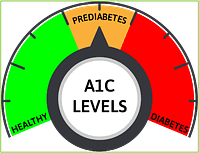Medical Fitness
How You Can Help Clients Living with Prediabetes to Mitigate Thier Risk for Developing Overt Type 2 Diabetes
People Living with Prediabetes can Reduce their Risk for Developing Overt Type 2 Diabetes with Lifestyle Modifications.
Prediabetes is defined as the intermediate state between normal blood glucose levels and below the levels used to diagnose diabetes. According to Diabetes Canada, nearly 6 million people in Canada are living with prediabetes; in the US, according to the CDC, that number is 88 million. It is estimated that nearly 1 in 3 Canadians and Americans are either diabetic, prediabetic or don’t know that they are prediabetic. That number is projected to grow.
There are several ways that a diagnosis of prediabetes can be made; two of the more common tests measure fasting blood glucose and A1C. The fasting blood glucose test is a simple blood test which measures blood glucose levels after you have not eaten for at least 8 hours and A1C is measured as a percentage and reflects your average blood sugar over the past 2-3 months.
 In Canada, a fasting glucose level of 6.1 to 6.9 mmol/L and an A1C of between 6.0 %– 6.4% indicates that someone has prediabetes according to Diabetes Canada.[i] In the US, someone is considered prediabetic with a fasting glucose level of 100–125 mg/dL and A1C of 5.7% to 6.4% according to the American Diabetes Association.
In Canada, a fasting glucose level of 6.1 to 6.9 mmol/L and an A1C of between 6.0 %– 6.4% indicates that someone has prediabetes according to Diabetes Canada.[i] In the US, someone is considered prediabetic with a fasting glucose level of 100–125 mg/dL and A1C of 5.7% to 6.4% according to the American Diabetes Association.
Prediabetes is increasingly recognized as an important metabolic state where early identification can allow earlier intervention, potentially lowering the number of those individuals who would progress from prediabetes to type 2 diabetes.
According to an article in Clinical Diabetes and Endocrinology,[ii] approximately 25% of those individuals with prediabetes will progress to overt type 2 diabetes within 3 to 5 years and as many as 70% of individuals with prediabetes will develop overt type 2 diabetes in their lifetime.
 As well as predisposing individuals to develop diabetes, prediabetes also increases the potential for other diseases such as neuropathy, retinopathy, heart disease, kidney disease and other chronic illnesses. This is especially true if the prediabetes is diagnosed as part of the ‘metabolic syndrome’ which also includes high blood pressure, higher levels of LDL cholesterol and triglyceride, lower levels of the “good” HDL cholesterol and excess fat around the waist (visceral fat), measured as above 35” for women and 40” for men.
As well as predisposing individuals to develop diabetes, prediabetes also increases the potential for other diseases such as neuropathy, retinopathy, heart disease, kidney disease and other chronic illnesses. This is especially true if the prediabetes is diagnosed as part of the ‘metabolic syndrome’ which also includes high blood pressure, higher levels of LDL cholesterol and triglyceride, lower levels of the “good” HDL cholesterol and excess fat around the waist (visceral fat), measured as above 35” for women and 40” for men.
Prediabetes, however, may be reversible through the implementation of the adoption of healthier diets and increased levels of physical activity as well as other lifestyle modifications.[iii] This is where specially trained Fitness Professionals such as a Diabetes Exercise Specialist can work with individuals who wish to reduce their risk for their prediabetes to progress. Without support, many of these individuals will go on to develop overt type 2 diabetes.
What can a Diabetes Exercise Specialist (DES) do to support their prediabetic clients?
 A DES can work with their prediabetic clients to help them make realistic, lasting lifestyle changes and help them to determine their own unique activity goals, needs and plans. A DES evaluates and monitors the client’s physical activity choices in the context of larger lifestyle management including blood-glucose, weight management and overall health goals and they can recommend specific individualized exercise programming. If necessary, they can explain anticipated responses to physical activity participation, injury prevention techniques, hypoglycemia (below normal blood glucose levels generally less than 4.0 mmol/l (70mg/dL) and hyperglycemia (excessive blood glucose generally higher than 11.1mmol/l (200mg/dl) prevention and management, hydration strategies, and potential short-term and long-term health complications.
A DES can work with their prediabetic clients to help them make realistic, lasting lifestyle changes and help them to determine their own unique activity goals, needs and plans. A DES evaluates and monitors the client’s physical activity choices in the context of larger lifestyle management including blood-glucose, weight management and overall health goals and they can recommend specific individualized exercise programming. If necessary, they can explain anticipated responses to physical activity participation, injury prevention techniques, hypoglycemia (below normal blood glucose levels generally less than 4.0 mmol/l (70mg/dL) and hyperglycemia (excessive blood glucose generally higher than 11.1mmol/l (200mg/dl) prevention and management, hydration strategies, and potential short-term and long-term health complications.
According to Diabetes Exercise Specialist Course Author, Dr. Sheri Colberg, PhD, FACSM, when it comes to prediabetes, education is Key. A DES can act as a community educator to the public and other health care professionals related to the importance of physical activity in prediabetes and diabetes management and type 2 diabetes prevention. For more information on the Diabetes Exercise Specialist course or to enroll in our Free Course Preview click HERE.
[i] Prediabetes – Diabetes Canada
[ii] Global epidemiology of prediabetes – present and future perspectives | Clinical Diabetes and Endocrinology | Full Text (biomedcentral.com)
[iii] The Surprising Truth About Prediabetes | CDC

